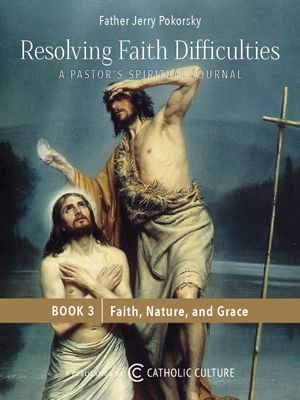Vatican II on the Liturgy: Related Concerns
By Dr. Jeff Mirus ( bio - articles - email ) | Feb 12, 2010 | In On the Documents of Vatican II
Having commented at some length on the Norms for liturgical renewal which first and foremost affect the Mass, the most important work for the understanding and importance of the Constitution on the Sacred Liturgy is completed. Still, as we have seen in the list of chapter titles, the Council did not neglect closely related subjects: the other sacraments, sacramentals, the Divine Office, the Liturgical year, sacred music and sacred art. I can touch only fleetingly on these topics.
Thus the Council calls for the extension of the vernacular in the other sacraments and sacramentals so that these may be more easily understood and appreciated. It further calls particular attention to the fact that Anointing of the Sick should not be construed (as it certainly was at the time) as a sacrament applicable only to those in imminent danger of death.
The Council also mandates a reform of the Divine Office (or Liturgy of the Hours). It calls for the restoration of the traditional sequence of the hours so that the Divine Office may be more easily used to sanctify the entire day; it stresses the importance of an excellent selection of readings from Scripture, the Fathers and other great saints; it encourages the laity to also make use of the Office (as many have since done); and it urges the public celebration of Vespers on major feasts and Sundays.
The Council also calls for a revised liturgical calendar to emphasize, first, the richness of Christ’s salvific work; second, the salvific importance and maternal solicitude of Mary; and third, the witness of the martyrs and saints. The Fathers also call strongly for the encouragement of both internal individual and external social penance during Lent.
In the area of sacred music, Gregorian Chant and the pipe organ are accorded pride of place, and instruction is given for the use of other musical compositions and instruments. Such instruments are always to be “suitable for sacred use” so that they “accord with the dignity of the temple, and truly contribute to the edification of the faithful” (120). Texts for chants and hymns are to be drawn from Scripture and liturgical sources.
And in the final chapter, norms are set down for education in, and the selection and cultivation of, sacred art. Given what we see so much of in Church architecture and Church adornment today, the following quote may occasion additional astonishment:
Bishops should be careful to ensure that works of art which are repugnant to faith, morals, and Christian piety, and which offend true religious sense either by depraved forms or through lack of artistic merit or because of mediocrity or pretense, be removed from the house of God and from other sacred places. (124)
One would think that such a stricture could have protected the faithful not only from many older, poorly-done and saccharine statues, but from crucifixes that look like grasshoppers and many a glib banner, not to mention churches which, in their fundamental architecture, more or less deliberately obliterate Christian symbolism or even any sense of the sacred at all.
But I digress, and we must mention in closing the unusual appendix, which addresses two special calendar issues, issues that must have been in the air then, but which I am quite sure very few will remember now. Thus, for the Church’s own liturgical calendar, the Council does not oppose the proposal of celebrating Easter on a fixed date, but only if it can be worked out with all concerned parties, including the Orthodox. For the civil calendar, the Council does not object to the proposal for a civil perpetual calendar as long as it preserves the seven-day week, which is essential to the rhythm of the Church’s life.
The sections devoted to these topics are quite short. On these and any of the topics summarized in this four-part commentary, a quick re-reading of the appropriate sections of Sacrosanctum Concilium itself will quickly acquaint the reader with the full mind of the Council. No consideration of the Liturgy can be complete, of course, without due attention to the many liturgical documents which have been issued since the Council. But in these days when the Pope is clearly working on a “reform of the reform”, it is important to return to Sacrosanctum Concilium so that we can better evaluate where the desires of Vatican II on the liturgy have been realized, and where they have been thwarted by those who claimed to implement the Council’s norms.
Previous in series: Vatican II on the Liturgy: Particular Norms & the Eucharist
Next in series: Vatican II on Social Communication
All comments are moderated. To lighten our editing burden, only current donors are allowed to Sound Off. If you are a current donor, log in to see the comment form; otherwise please support our work, and Sound Off!
-
Posted by: -
Feb. 27, 2014 6:50 AM ET USA
I appreciate your analysis. It seems however you start with a sort of check list and make a sort of report card. When it comes to use of Latin you should weigh in with a failing grade. Same goes for music.I want to attend a OF mass, but for now attend the EF if for no other reason than this-- "The musical tradition of the universal Church is a treasure of inestimable value, greater even than that of any other art." Too powerful are the forces in most parishes that work in opposition to this idea
-
Posted by: Jeff Mirus -
Feb. 13, 2010 2:36 PM ET USA
The documents of ecumenical councils are not proposed to the Church as matters for debate. For these summaries of the documents of Vatican II, we are not accepting Sound Off! posts which criticize what the Council said. Any magisterial document could be criticized for not saying what someone wished; this is hardly the point. However, comments on any deficiencies in my summaries are most welcome here, while strategies for how to proceed in the future are best discussed later.








